Strategic Analysis of Wesfarmers
VerifiedAdded on 2023/06/05
|10
|2666
|246
AI Summary
This article provides a detailed strategic analysis of Wesfarmers, including its external analysis, industry environment, resources, capabilities, and proposed systems. It also discusses the threats and opportunities faced by the organization.
Contribute Materials
Your contribution can guide someone’s learning journey. Share your
documents today.
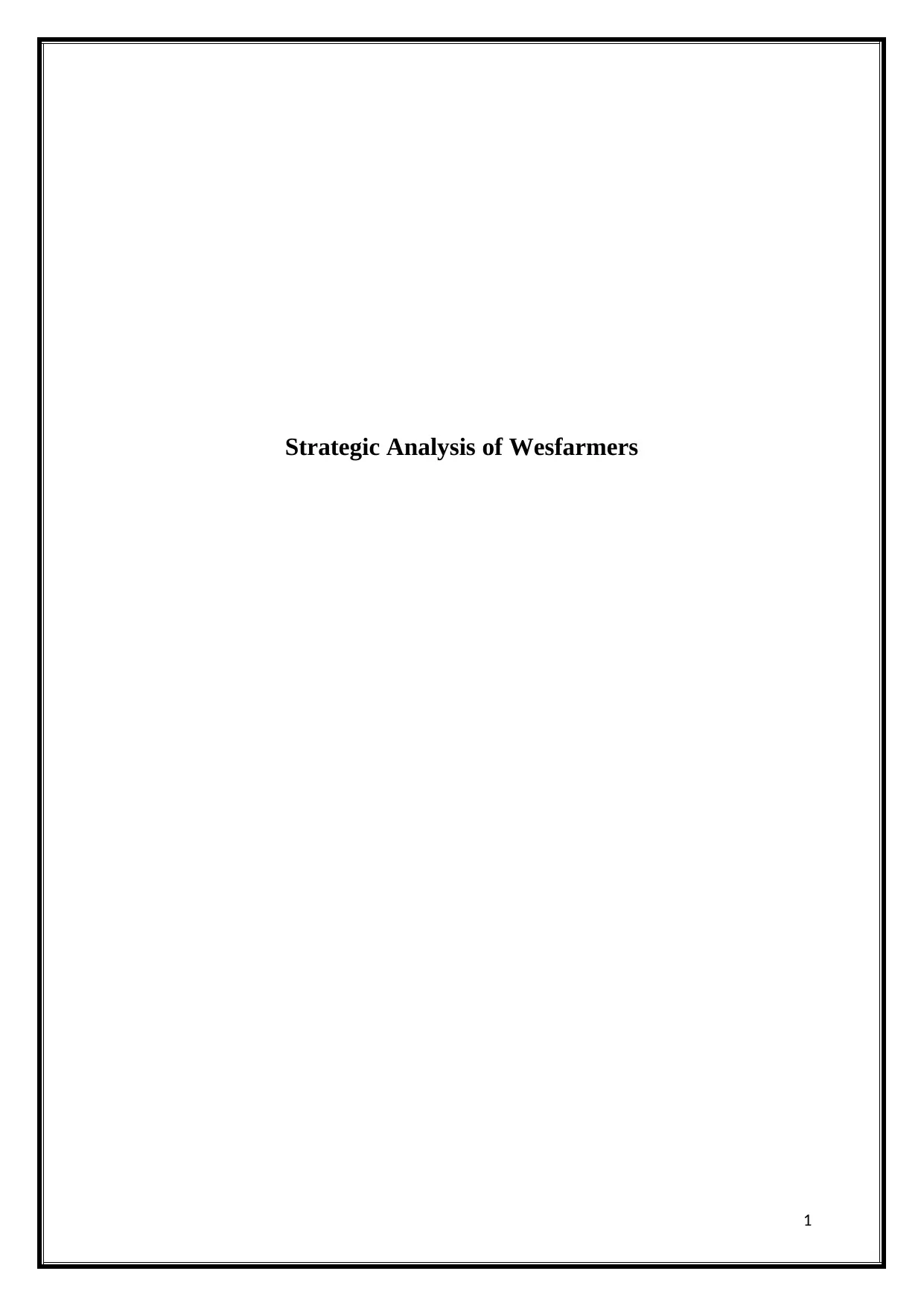
Strategic Analysis of Wesfarmers
1
1
Secure Best Marks with AI Grader
Need help grading? Try our AI Grader for instant feedback on your assignments.
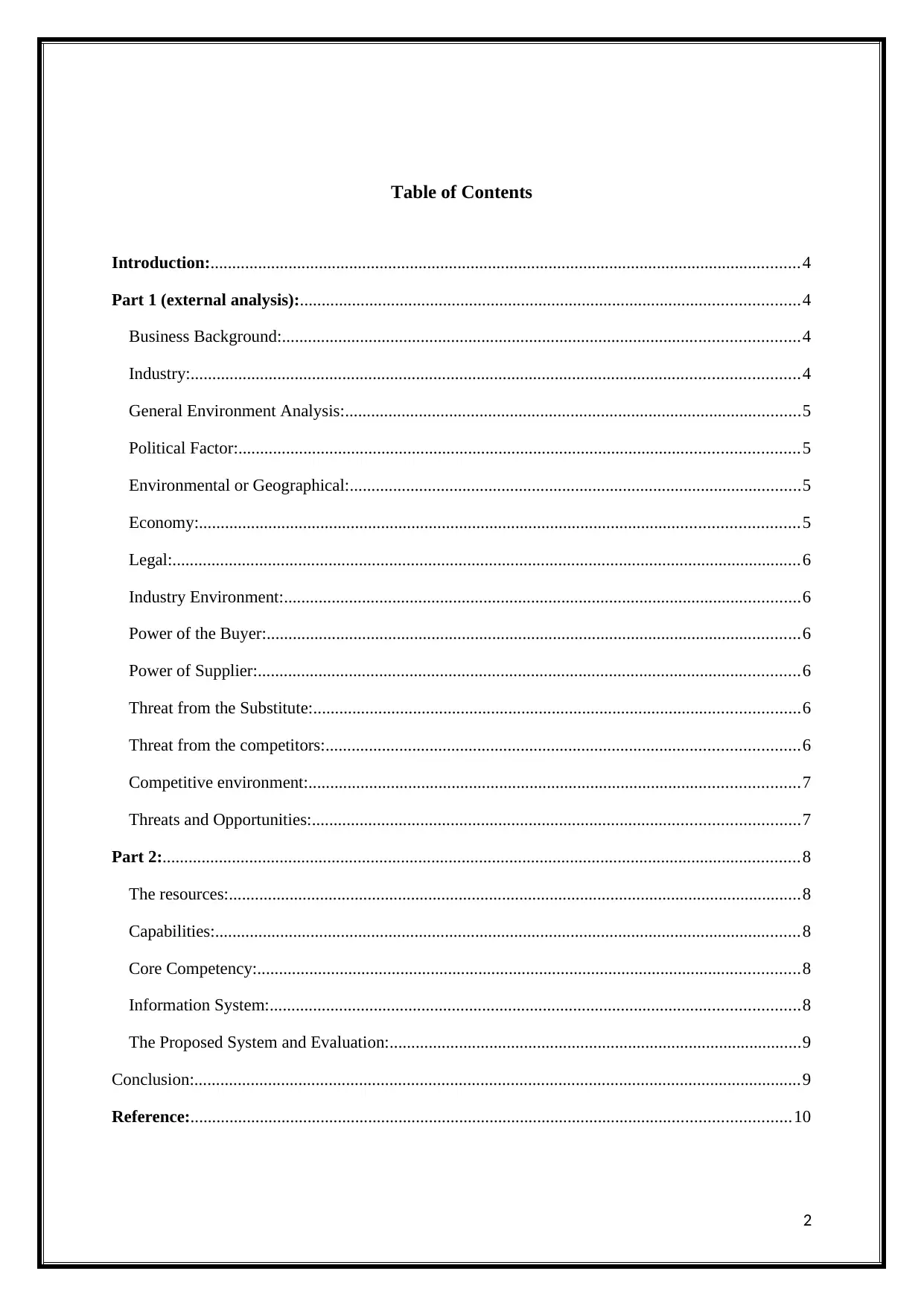
Table of Contents
Introduction:........................................................................................................................................4
Part 1 (external analysis):...................................................................................................................4
Business Background:.......................................................................................................................4
Industry:............................................................................................................................................4
General Environment Analysis:.........................................................................................................5
Political Factor:.................................................................................................................................5
Environmental or Geographical:........................................................................................................5
Economy:..........................................................................................................................................5
Legal:.................................................................................................................................................6
Industry Environment:.......................................................................................................................6
Power of the Buyer:...........................................................................................................................6
Power of Supplier:.............................................................................................................................6
Threat from the Substitute:................................................................................................................6
Threat from the competitors:.............................................................................................................6
Competitive environment:.................................................................................................................7
Threats and Opportunities:................................................................................................................7
Part 2:...................................................................................................................................................8
The resources:....................................................................................................................................8
Capabilities:.......................................................................................................................................8
Core Competency:.............................................................................................................................8
Information System:..........................................................................................................................8
The Proposed System and Evaluation:...............................................................................................9
Conclusion:............................................................................................................................................9
Reference:..........................................................................................................................................10
2
Introduction:........................................................................................................................................4
Part 1 (external analysis):...................................................................................................................4
Business Background:.......................................................................................................................4
Industry:............................................................................................................................................4
General Environment Analysis:.........................................................................................................5
Political Factor:.................................................................................................................................5
Environmental or Geographical:........................................................................................................5
Economy:..........................................................................................................................................5
Legal:.................................................................................................................................................6
Industry Environment:.......................................................................................................................6
Power of the Buyer:...........................................................................................................................6
Power of Supplier:.............................................................................................................................6
Threat from the Substitute:................................................................................................................6
Threat from the competitors:.............................................................................................................6
Competitive environment:.................................................................................................................7
Threats and Opportunities:................................................................................................................7
Part 2:...................................................................................................................................................8
The resources:....................................................................................................................................8
Capabilities:.......................................................................................................................................8
Core Competency:.............................................................................................................................8
Information System:..........................................................................................................................8
The Proposed System and Evaluation:...............................................................................................9
Conclusion:............................................................................................................................................9
Reference:..........................................................................................................................................10
2
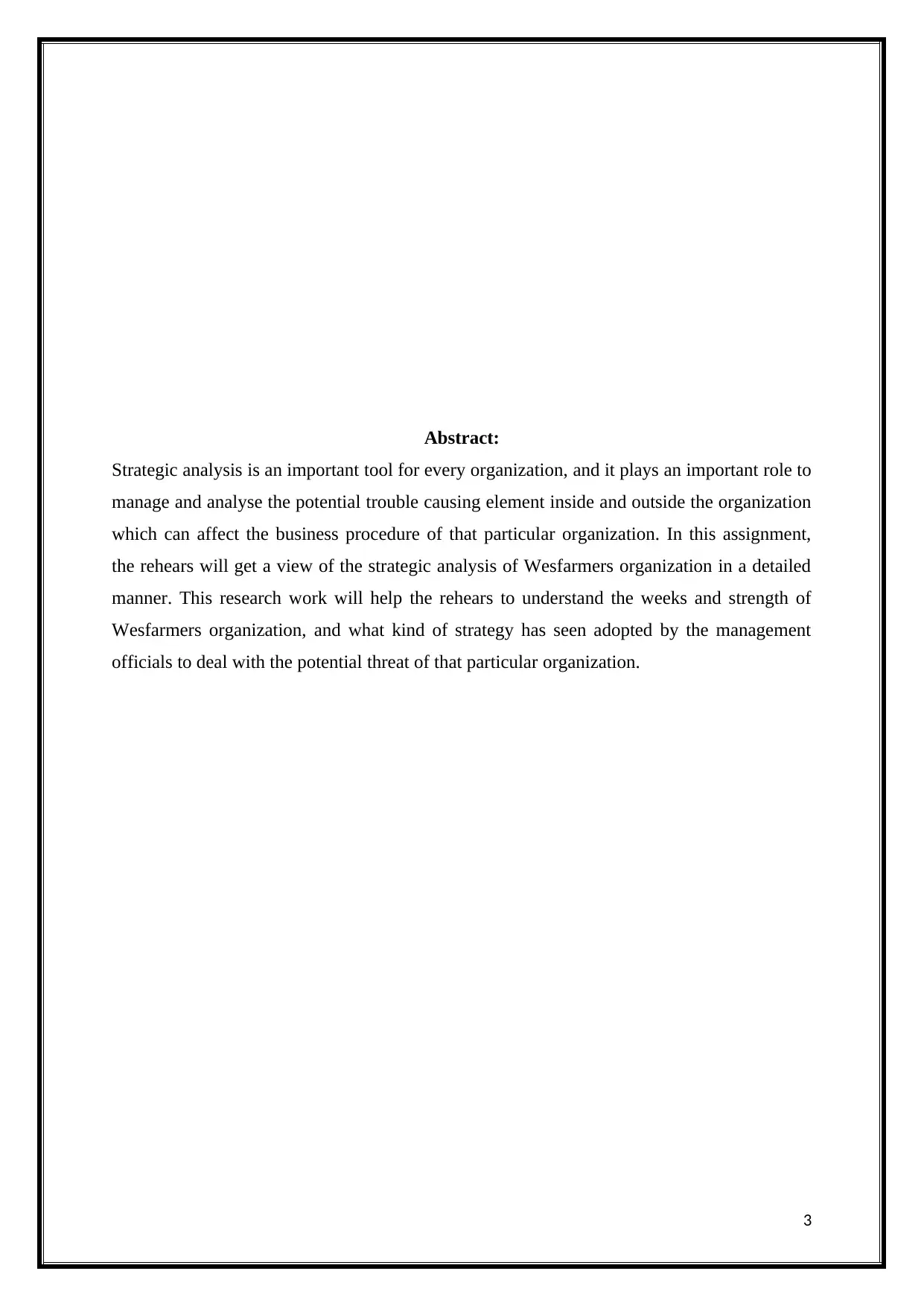
Abstract:
Strategic analysis is an important tool for every organization, and it plays an important role to
manage and analyse the potential trouble causing element inside and outside the organization
which can affect the business procedure of that particular organization. In this assignment,
the rehears will get a view of the strategic analysis of Wesfarmers organization in a detailed
manner. This research work will help the rehears to understand the weeks and strength of
Wesfarmers organization, and what kind of strategy has seen adopted by the management
officials to deal with the potential threat of that particular organization.
3
Strategic analysis is an important tool for every organization, and it plays an important role to
manage and analyse the potential trouble causing element inside and outside the organization
which can affect the business procedure of that particular organization. In this assignment,
the rehears will get a view of the strategic analysis of Wesfarmers organization in a detailed
manner. This research work will help the rehears to understand the weeks and strength of
Wesfarmers organization, and what kind of strategy has seen adopted by the management
officials to deal with the potential threat of that particular organization.
3
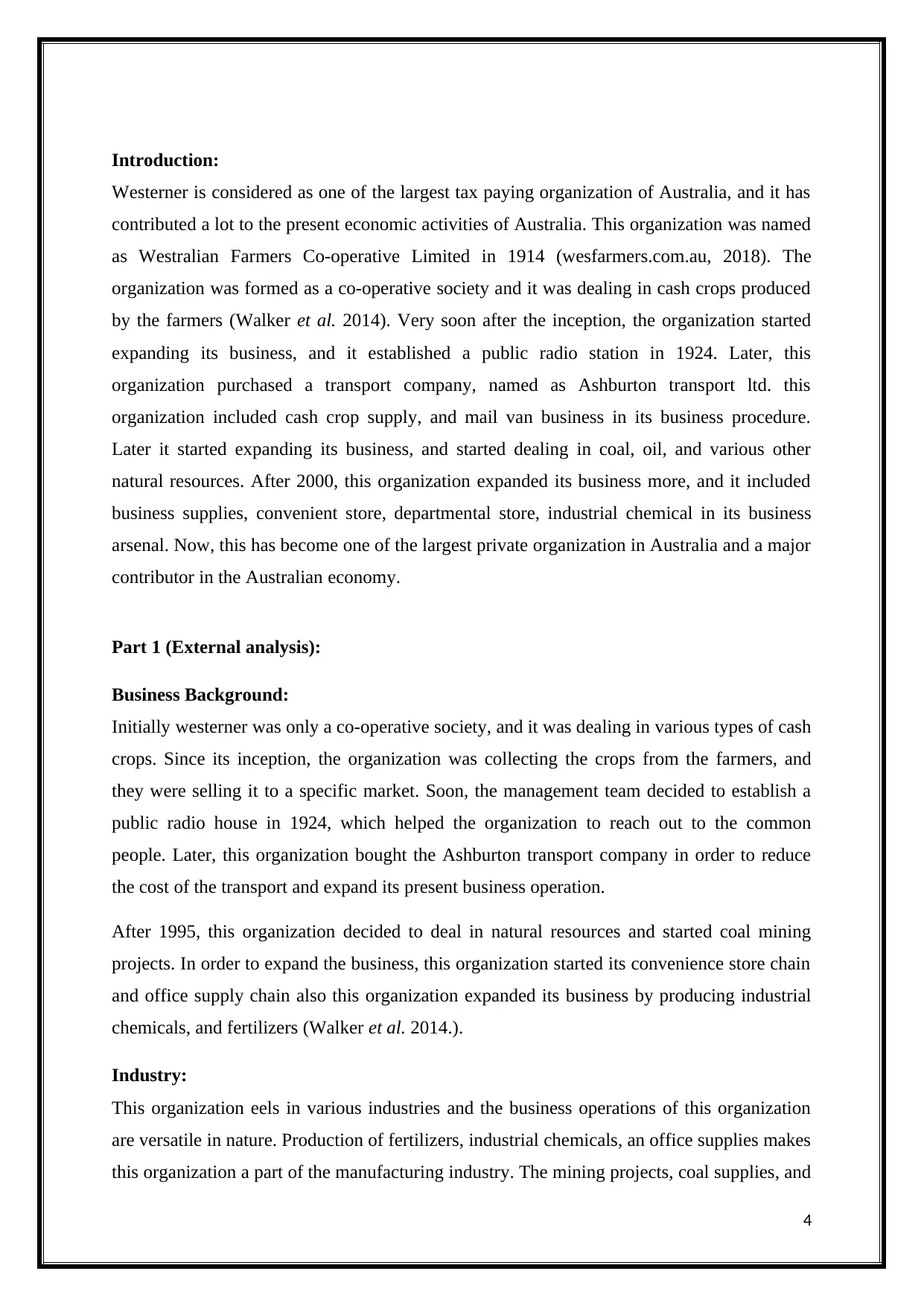
Introduction:
Westerner is considered as one of the largest tax paying organization of Australia, and it has
contributed a lot to the present economic activities of Australia. This organization was named
as Westralian Farmers Co-operative Limited in 1914 (wesfarmers.com.au, 2018). The
organization was formed as a co-operative society and it was dealing in cash crops produced
by the farmers (Walker et al. 2014). Very soon after the inception, the organization started
expanding its business, and it established a public radio station in 1924. Later, this
organization purchased a transport company, named as Ashburton transport ltd. this
organization included cash crop supply, and mail van business in its business procedure.
Later it started expanding its business, and started dealing in coal, oil, and various other
natural resources. After 2000, this organization expanded its business more, and it included
business supplies, convenient store, departmental store, industrial chemical in its business
arsenal. Now, this has become one of the largest private organization in Australia and a major
contributor in the Australian economy.
Part 1 (External analysis):
Business Background:
Initially westerner was only a co-operative society, and it was dealing in various types of cash
crops. Since its inception, the organization was collecting the crops from the farmers, and
they were selling it to a specific market. Soon, the management team decided to establish a
public radio house in 1924, which helped the organization to reach out to the common
people. Later, this organization bought the Ashburton transport company in order to reduce
the cost of the transport and expand its present business operation.
After 1995, this organization decided to deal in natural resources and started coal mining
projects. In order to expand the business, this organization started its convenience store chain
and office supply chain also this organization expanded its business by producing industrial
chemicals, and fertilizers (Walker et al. 2014.).
Industry:
This organization eels in various industries and the business operations of this organization
are versatile in nature. Production of fertilizers, industrial chemicals, an office supplies makes
this organization a part of the manufacturing industry. The mining projects, coal supplies, and
4
Westerner is considered as one of the largest tax paying organization of Australia, and it has
contributed a lot to the present economic activities of Australia. This organization was named
as Westralian Farmers Co-operative Limited in 1914 (wesfarmers.com.au, 2018). The
organization was formed as a co-operative society and it was dealing in cash crops produced
by the farmers (Walker et al. 2014). Very soon after the inception, the organization started
expanding its business, and it established a public radio station in 1924. Later, this
organization purchased a transport company, named as Ashburton transport ltd. this
organization included cash crop supply, and mail van business in its business procedure.
Later it started expanding its business, and started dealing in coal, oil, and various other
natural resources. After 2000, this organization expanded its business more, and it included
business supplies, convenient store, departmental store, industrial chemical in its business
arsenal. Now, this has become one of the largest private organization in Australia and a major
contributor in the Australian economy.
Part 1 (External analysis):
Business Background:
Initially westerner was only a co-operative society, and it was dealing in various types of cash
crops. Since its inception, the organization was collecting the crops from the farmers, and
they were selling it to a specific market. Soon, the management team decided to establish a
public radio house in 1924, which helped the organization to reach out to the common
people. Later, this organization bought the Ashburton transport company in order to reduce
the cost of the transport and expand its present business operation.
After 1995, this organization decided to deal in natural resources and started coal mining
projects. In order to expand the business, this organization started its convenience store chain
and office supply chain also this organization expanded its business by producing industrial
chemicals, and fertilizers (Walker et al. 2014.).
Industry:
This organization eels in various industries and the business operations of this organization
are versatile in nature. Production of fertilizers, industrial chemicals, an office supplies makes
this organization a part of the manufacturing industry. The mining projects, coal supplies, and
4
Secure Best Marks with AI Grader
Need help grading? Try our AI Grader for instant feedback on your assignments.

oil refinery makes it a part of the mining industry. Also, this organization deals in cash crops
which makes it a part of the agriculture industry. The organization also runs a chain of
convenience store, and departmental store which is under the FMCG market. So, it is quite
clear that this organization operates in different types of industry which also makes it unique
in nature.
General Environment Analysis:
The environment of the market has a great impact on the business operations of every
organization. Here the PESTEL analysis format has been chosen in order to analyse the
impact of the external factors. PESTEL stands for political, social, environmental or the
geographical, economic, and legal factors. These factors play a huge role in the entire
business procedure of an organization, and it can affect the objectives of the organization
significantly (Galliers, and Leidner, 2014).
Political Factor:
Since the inception of the organization, the political scenario of Australia was not stable in
nature. Though, the legislation of Australia was always business friendly. That is why; the
growth of this organization at its initial stage was stagnant. Though, with the changing time
the political scenario of Australia changed a lot. The political scenario became more business
friendly, and the legislation created an open and competitive marketplace for the
organizations (Zahra and Chaples, 2013). It attracted multiple foreign investors, and the
market place became equally available for all. Though, the strict labour law, and the
increasing wages of the labours have affected the human resource based organization
(Galliers, and Leidner, 2014).
Environmental or Geographical:
The regional environment or the geography plays a crucial role in every organization, and
these factors have a huge impact on the objectives of the organization. Depending upon the
geographical factors, this organization took various important business decisions. Like, what
kind of crops they will be dealing in, and the mining projects. Australia is full of natural
resources, and that is why, this organization opted for mining projects and industrial chemical
manufacturing.
Economy:
In the 19th century, the economy of Australia was not flexible enough and that is quite
prominent on the growth and development of this organization. But, with the changing time
5
which makes it a part of the agriculture industry. The organization also runs a chain of
convenience store, and departmental store which is under the FMCG market. So, it is quite
clear that this organization operates in different types of industry which also makes it unique
in nature.
General Environment Analysis:
The environment of the market has a great impact on the business operations of every
organization. Here the PESTEL analysis format has been chosen in order to analyse the
impact of the external factors. PESTEL stands for political, social, environmental or the
geographical, economic, and legal factors. These factors play a huge role in the entire
business procedure of an organization, and it can affect the objectives of the organization
significantly (Galliers, and Leidner, 2014).
Political Factor:
Since the inception of the organization, the political scenario of Australia was not stable in
nature. Though, the legislation of Australia was always business friendly. That is why; the
growth of this organization at its initial stage was stagnant. Though, with the changing time
the political scenario of Australia changed a lot. The political scenario became more business
friendly, and the legislation created an open and competitive marketplace for the
organizations (Zahra and Chaples, 2013). It attracted multiple foreign investors, and the
market place became equally available for all. Though, the strict labour law, and the
increasing wages of the labours have affected the human resource based organization
(Galliers, and Leidner, 2014).
Environmental or Geographical:
The regional environment or the geography plays a crucial role in every organization, and
these factors have a huge impact on the objectives of the organization. Depending upon the
geographical factors, this organization took various important business decisions. Like, what
kind of crops they will be dealing in, and the mining projects. Australia is full of natural
resources, and that is why, this organization opted for mining projects and industrial chemical
manufacturing.
Economy:
In the 19th century, the economy of Australia was not flexible enough and that is quite
prominent on the growth and development of this organization. But, with the changing time
5

the economy of Australia has changed a lot, and according t that the tax structure for the
organization has also changed. This has opened up new opportunities for the organization,
and the private organizations has received multiple benefits room the government subsidies
(Galliers, and Leidner, 2014).
Legal:
The Australia legislation is known as the most business friendly legislation. Here setting up a
new business is easer compared to other developed countries, and the import and export
duties are also business friendly. The exclusive ties with the other countries have helped
organizations like Wesfarmers to import and export their products to the different parts of the
world (Galliers, and Leidner, 2014).
Industry Environment:
In order to analyse the industry environment the P5 analysis technique has been adopted.
Porter’s five forces deal with various influencing factors. Porters five forces deal with the
factors like power of the supplier, power of the buyer, potential threat from the substitute, and
the threat from the competitors.
Power of the Buyer:
The power of the buyer and the economy of the country go hand in hand. If the purchasing
power of the consumer is too low, then it is very default for any organization to grow. The
organization realised the power of the buyer from the initial days, and that is why it game
priority to the pricing of the products.
Power of Supplier:
The power of supplier of any organization is inevitable, and this is also prominent in the
business procedures of this organization as well. This organization is heavily dependent of
the suppliers to get the raw materials and that is why the risk of the scarcity of the resources
remains high for this organization.
Threat from the Substitute:
This organization is constantly facing the threat of being replaced by the substitutes. All the
products of this organization is easy available, and there are multiple competitors who are
dealing with the similar kind of products. This organization is dealing with this problem by
keeping the cost of the products low, and heavy advertising campaigns.
6
organization has also changed. This has opened up new opportunities for the organization,
and the private organizations has received multiple benefits room the government subsidies
(Galliers, and Leidner, 2014).
Legal:
The Australia legislation is known as the most business friendly legislation. Here setting up a
new business is easer compared to other developed countries, and the import and export
duties are also business friendly. The exclusive ties with the other countries have helped
organizations like Wesfarmers to import and export their products to the different parts of the
world (Galliers, and Leidner, 2014).
Industry Environment:
In order to analyse the industry environment the P5 analysis technique has been adopted.
Porter’s five forces deal with various influencing factors. Porters five forces deal with the
factors like power of the supplier, power of the buyer, potential threat from the substitute, and
the threat from the competitors.
Power of the Buyer:
The power of the buyer and the economy of the country go hand in hand. If the purchasing
power of the consumer is too low, then it is very default for any organization to grow. The
organization realised the power of the buyer from the initial days, and that is why it game
priority to the pricing of the products.
Power of Supplier:
The power of supplier of any organization is inevitable, and this is also prominent in the
business procedures of this organization as well. This organization is heavily dependent of
the suppliers to get the raw materials and that is why the risk of the scarcity of the resources
remains high for this organization.
Threat from the Substitute:
This organization is constantly facing the threat of being replaced by the substitutes. All the
products of this organization is easy available, and there are multiple competitors who are
dealing with the similar kind of products. This organization is dealing with this problem by
keeping the cost of the products low, and heavy advertising campaigns.
6
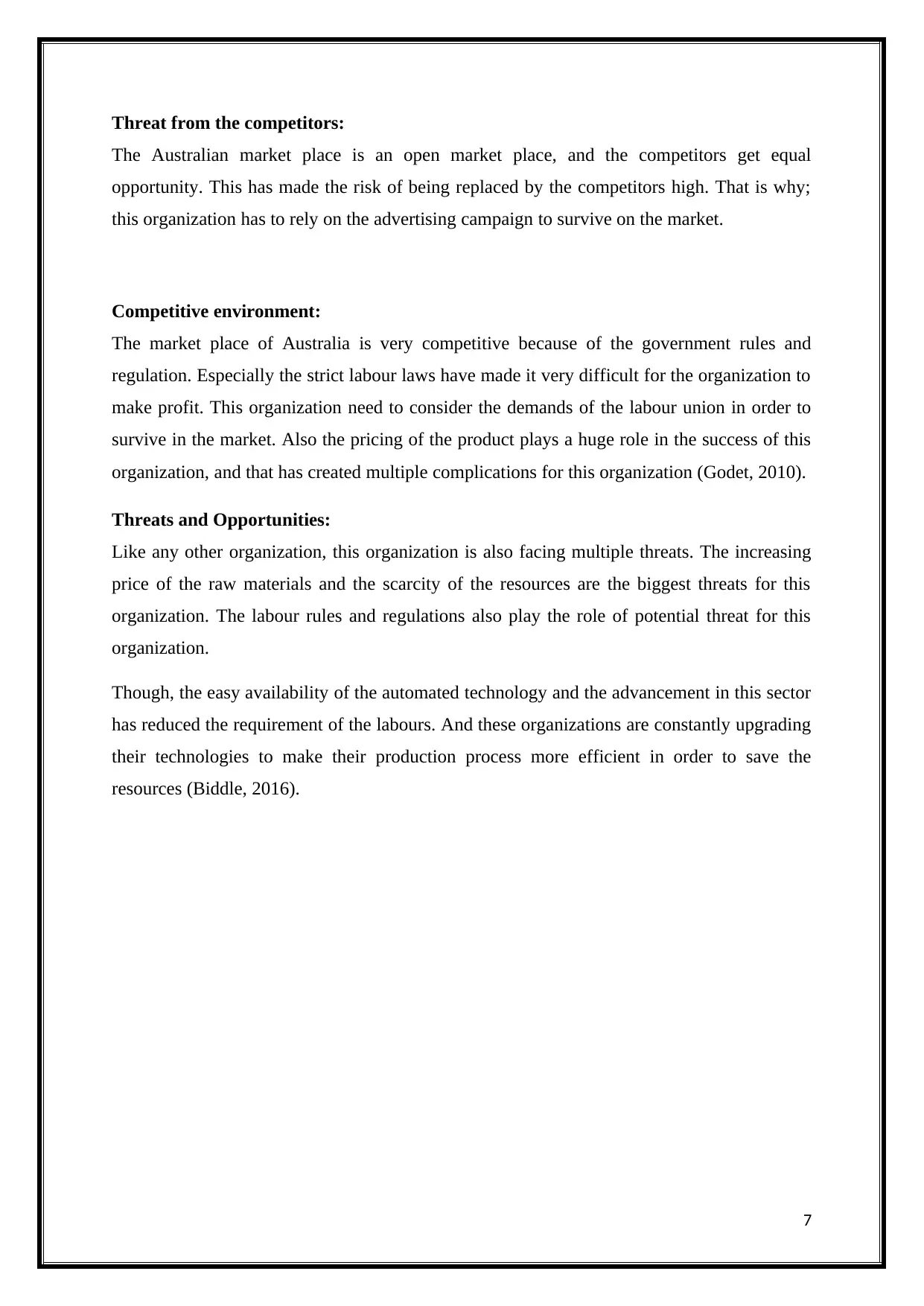
Threat from the competitors:
The Australian market place is an open market place, and the competitors get equal
opportunity. This has made the risk of being replaced by the competitors high. That is why;
this organization has to rely on the advertising campaign to survive on the market.
Competitive environment:
The market place of Australia is very competitive because of the government rules and
regulation. Especially the strict labour laws have made it very difficult for the organization to
make profit. This organization need to consider the demands of the labour union in order to
survive in the market. Also the pricing of the product plays a huge role in the success of this
organization, and that has created multiple complications for this organization (Godet, 2010).
Threats and Opportunities:
Like any other organization, this organization is also facing multiple threats. The increasing
price of the raw materials and the scarcity of the resources are the biggest threats for this
organization. The labour rules and regulations also play the role of potential threat for this
organization.
Though, the easy availability of the automated technology and the advancement in this sector
has reduced the requirement of the labours. And these organizations are constantly upgrading
their technologies to make their production process more efficient in order to save the
resources (Biddle, 2016).
7
The Australian market place is an open market place, and the competitors get equal
opportunity. This has made the risk of being replaced by the competitors high. That is why;
this organization has to rely on the advertising campaign to survive on the market.
Competitive environment:
The market place of Australia is very competitive because of the government rules and
regulation. Especially the strict labour laws have made it very difficult for the organization to
make profit. This organization need to consider the demands of the labour union in order to
survive in the market. Also the pricing of the product plays a huge role in the success of this
organization, and that has created multiple complications for this organization (Godet, 2010).
Threats and Opportunities:
Like any other organization, this organization is also facing multiple threats. The increasing
price of the raw materials and the scarcity of the resources are the biggest threats for this
organization. The labour rules and regulations also play the role of potential threat for this
organization.
Though, the easy availability of the automated technology and the advancement in this sector
has reduced the requirement of the labours. And these organizations are constantly upgrading
their technologies to make their production process more efficient in order to save the
resources (Biddle, 2016).
7
Paraphrase This Document
Need a fresh take? Get an instant paraphrase of this document with our AI Paraphraser
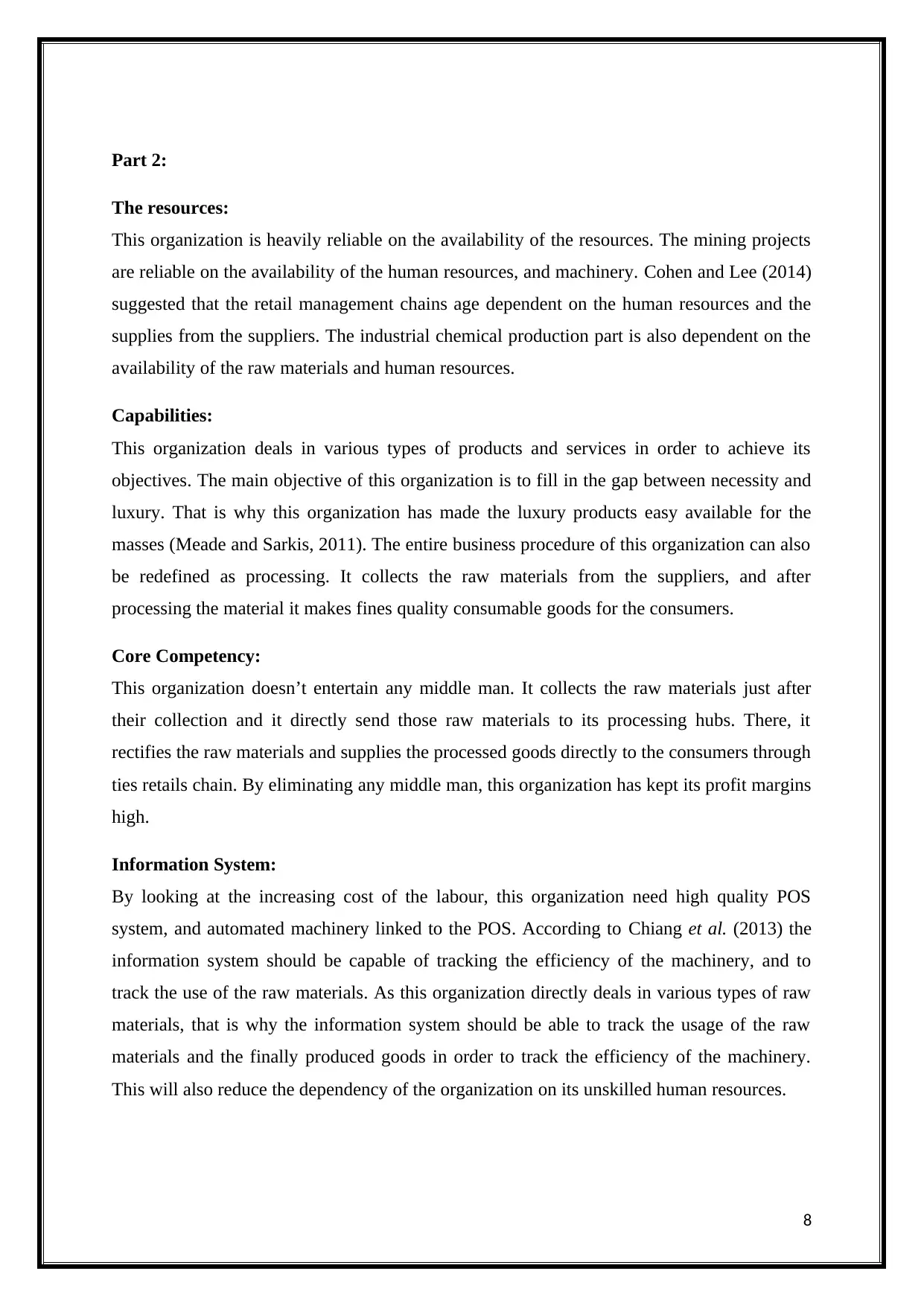
Part 2:
The resources:
This organization is heavily reliable on the availability of the resources. The mining projects
are reliable on the availability of the human resources, and machinery. Cohen and Lee (2014)
suggested that the retail management chains age dependent on the human resources and the
supplies from the suppliers. The industrial chemical production part is also dependent on the
availability of the raw materials and human resources.
Capabilities:
This organization deals in various types of products and services in order to achieve its
objectives. The main objective of this organization is to fill in the gap between necessity and
luxury. That is why this organization has made the luxury products easy available for the
masses (Meade and Sarkis, 2011). The entire business procedure of this organization can also
be redefined as processing. It collects the raw materials from the suppliers, and after
processing the material it makes fines quality consumable goods for the consumers.
Core Competency:
This organization doesn’t entertain any middle man. It collects the raw materials just after
their collection and it directly send those raw materials to its processing hubs. There, it
rectifies the raw materials and supplies the processed goods directly to the consumers through
ties retails chain. By eliminating any middle man, this organization has kept its profit margins
high.
Information System:
By looking at the increasing cost of the labour, this organization need high quality POS
system, and automated machinery linked to the POS. According to Chiang et al. (2013) the
information system should be capable of tracking the efficiency of the machinery, and to
track the use of the raw materials. As this organization directly deals in various types of raw
materials, that is why the information system should be able to track the usage of the raw
materials and the finally produced goods in order to track the efficiency of the machinery.
This will also reduce the dependency of the organization on its unskilled human resources.
8
The resources:
This organization is heavily reliable on the availability of the resources. The mining projects
are reliable on the availability of the human resources, and machinery. Cohen and Lee (2014)
suggested that the retail management chains age dependent on the human resources and the
supplies from the suppliers. The industrial chemical production part is also dependent on the
availability of the raw materials and human resources.
Capabilities:
This organization deals in various types of products and services in order to achieve its
objectives. The main objective of this organization is to fill in the gap between necessity and
luxury. That is why this organization has made the luxury products easy available for the
masses (Meade and Sarkis, 2011). The entire business procedure of this organization can also
be redefined as processing. It collects the raw materials from the suppliers, and after
processing the material it makes fines quality consumable goods for the consumers.
Core Competency:
This organization doesn’t entertain any middle man. It collects the raw materials just after
their collection and it directly send those raw materials to its processing hubs. There, it
rectifies the raw materials and supplies the processed goods directly to the consumers through
ties retails chain. By eliminating any middle man, this organization has kept its profit margins
high.
Information System:
By looking at the increasing cost of the labour, this organization need high quality POS
system, and automated machinery linked to the POS. According to Chiang et al. (2013) the
information system should be capable of tracking the efficiency of the machinery, and to
track the use of the raw materials. As this organization directly deals in various types of raw
materials, that is why the information system should be able to track the usage of the raw
materials and the finally produced goods in order to track the efficiency of the machinery.
This will also reduce the dependency of the organization on its unskilled human resources.
8
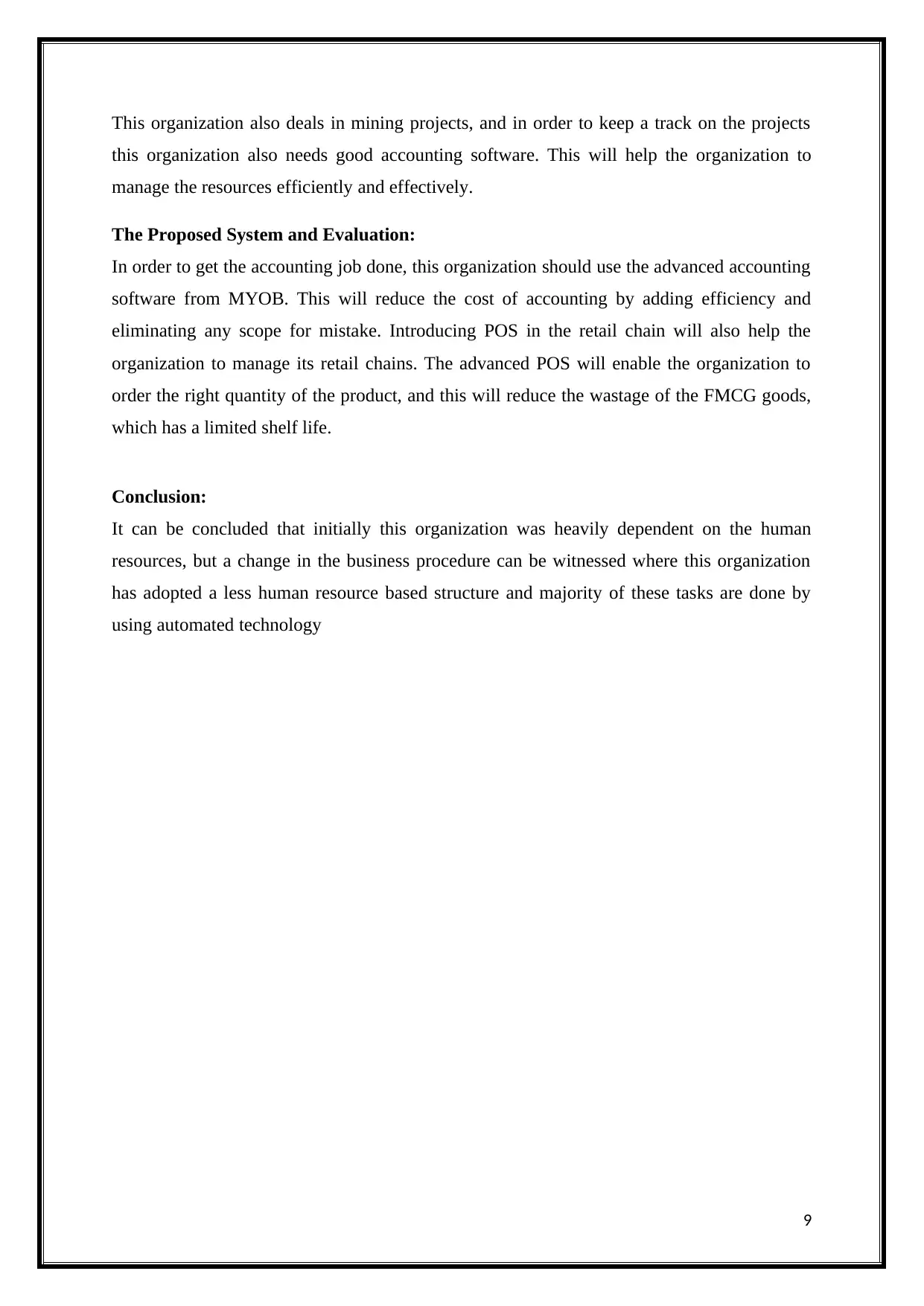
This organization also deals in mining projects, and in order to keep a track on the projects
this organization also needs good accounting software. This will help the organization to
manage the resources efficiently and effectively.
The Proposed System and Evaluation:
In order to get the accounting job done, this organization should use the advanced accounting
software from MYOB. This will reduce the cost of accounting by adding efficiency and
eliminating any scope for mistake. Introducing POS in the retail chain will also help the
organization to manage its retail chains. The advanced POS will enable the organization to
order the right quantity of the product, and this will reduce the wastage of the FMCG goods,
which has a limited shelf life.
Conclusion:
It can be concluded that initially this organization was heavily dependent on the human
resources, but a change in the business procedure can be witnessed where this organization
has adopted a less human resource based structure and majority of these tasks are done by
using automated technology
9
this organization also needs good accounting software. This will help the organization to
manage the resources efficiently and effectively.
The Proposed System and Evaluation:
In order to get the accounting job done, this organization should use the advanced accounting
software from MYOB. This will reduce the cost of accounting by adding efficiency and
eliminating any scope for mistake. Introducing POS in the retail chain will also help the
organization to manage its retail chains. The advanced POS will enable the organization to
order the right quantity of the product, and this will reduce the wastage of the FMCG goods,
which has a limited shelf life.
Conclusion:
It can be concluded that initially this organization was heavily dependent on the human
resources, but a change in the business procedure can be witnessed where this organization
has adopted a less human resource based structure and majority of these tasks are done by
using automated technology
9
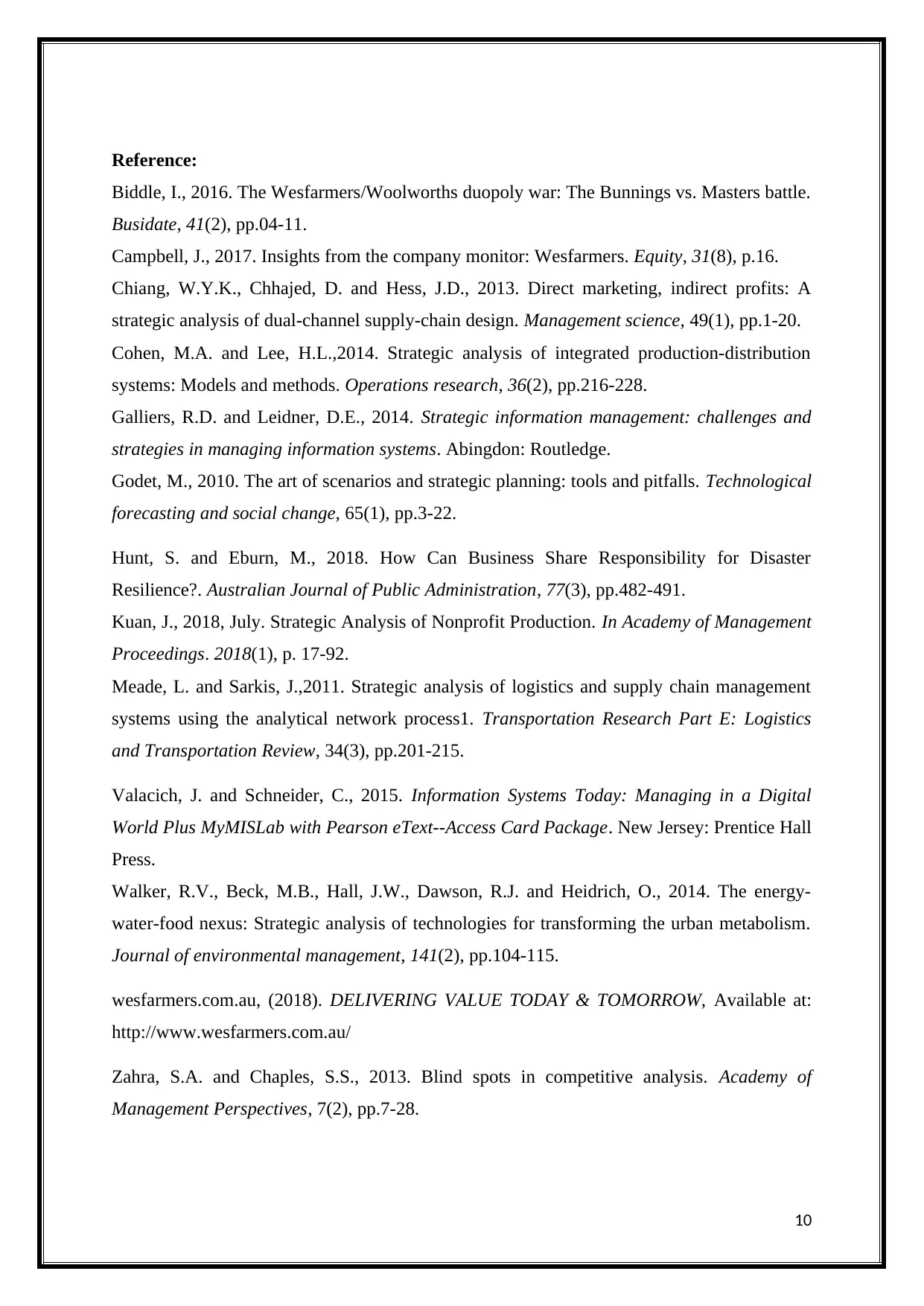
Reference:
Biddle, I., 2016. The Wesfarmers/Woolworths duopoly war: The Bunnings vs. Masters battle.
Busidate, 41(2), pp.04-11.
Campbell, J., 2017. Insights from the company monitor: Wesfarmers. Equity, 31(8), p.16.
Chiang, W.Y.K., Chhajed, D. and Hess, J.D., 2013. Direct marketing, indirect profits: A
strategic analysis of dual-channel supply-chain design. Management science, 49(1), pp.1-20.
Cohen, M.A. and Lee, H.L.,2014. Strategic analysis of integrated production-distribution
systems: Models and methods. Operations research, 36(2), pp.216-228.
Galliers, R.D. and Leidner, D.E., 2014. Strategic information management: challenges and
strategies in managing information systems. Abingdon: Routledge.
Godet, M., 2010. The art of scenarios and strategic planning: tools and pitfalls. Technological
forecasting and social change, 65(1), pp.3-22.
Hunt, S. and Eburn, M., 2018. How Can Business Share Responsibility for Disaster
Resilience?. Australian Journal of Public Administration, 77(3), pp.482-491.
Kuan, J., 2018, July. Strategic Analysis of Nonprofit Production. In Academy of Management
Proceedings. 2018(1), p. 17-92.
Meade, L. and Sarkis, J.,2011. Strategic analysis of logistics and supply chain management
systems using the analytical network process1. Transportation Research Part E: Logistics
and Transportation Review, 34(3), pp.201-215.
Valacich, J. and Schneider, C., 2015. Information Systems Today: Managing in a Digital
World Plus MyMISLab with Pearson eText--Access Card Package. New Jersey: Prentice Hall
Press.
Walker, R.V., Beck, M.B., Hall, J.W., Dawson, R.J. and Heidrich, O., 2014. The energy-
water-food nexus: Strategic analysis of technologies for transforming the urban metabolism.
Journal of environmental management, 141(2), pp.104-115.
wesfarmers.com.au, (2018). DELIVERING VALUE TODAY & TOMORROW, Available at:
http://www.wesfarmers.com.au/
Zahra, S.A. and Chaples, S.S., 2013. Blind spots in competitive analysis. Academy of
Management Perspectives, 7(2), pp.7-28.
10
Biddle, I., 2016. The Wesfarmers/Woolworths duopoly war: The Bunnings vs. Masters battle.
Busidate, 41(2), pp.04-11.
Campbell, J., 2017. Insights from the company monitor: Wesfarmers. Equity, 31(8), p.16.
Chiang, W.Y.K., Chhajed, D. and Hess, J.D., 2013. Direct marketing, indirect profits: A
strategic analysis of dual-channel supply-chain design. Management science, 49(1), pp.1-20.
Cohen, M.A. and Lee, H.L.,2014. Strategic analysis of integrated production-distribution
systems: Models and methods. Operations research, 36(2), pp.216-228.
Galliers, R.D. and Leidner, D.E., 2014. Strategic information management: challenges and
strategies in managing information systems. Abingdon: Routledge.
Godet, M., 2010. The art of scenarios and strategic planning: tools and pitfalls. Technological
forecasting and social change, 65(1), pp.3-22.
Hunt, S. and Eburn, M., 2018. How Can Business Share Responsibility for Disaster
Resilience?. Australian Journal of Public Administration, 77(3), pp.482-491.
Kuan, J., 2018, July. Strategic Analysis of Nonprofit Production. In Academy of Management
Proceedings. 2018(1), p. 17-92.
Meade, L. and Sarkis, J.,2011. Strategic analysis of logistics and supply chain management
systems using the analytical network process1. Transportation Research Part E: Logistics
and Transportation Review, 34(3), pp.201-215.
Valacich, J. and Schneider, C., 2015. Information Systems Today: Managing in a Digital
World Plus MyMISLab with Pearson eText--Access Card Package. New Jersey: Prentice Hall
Press.
Walker, R.V., Beck, M.B., Hall, J.W., Dawson, R.J. and Heidrich, O., 2014. The energy-
water-food nexus: Strategic analysis of technologies for transforming the urban metabolism.
Journal of environmental management, 141(2), pp.104-115.
wesfarmers.com.au, (2018). DELIVERING VALUE TODAY & TOMORROW, Available at:
http://www.wesfarmers.com.au/
Zahra, S.A. and Chaples, S.S., 2013. Blind spots in competitive analysis. Academy of
Management Perspectives, 7(2), pp.7-28.
10
1 out of 10
Your All-in-One AI-Powered Toolkit for Academic Success.
+13062052269
info@desklib.com
Available 24*7 on WhatsApp / Email
![[object Object]](/_next/static/media/star-bottom.7253800d.svg)
Unlock your academic potential
© 2024 | Zucol Services PVT LTD | All rights reserved.





